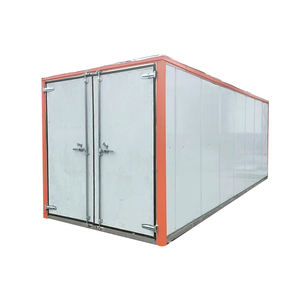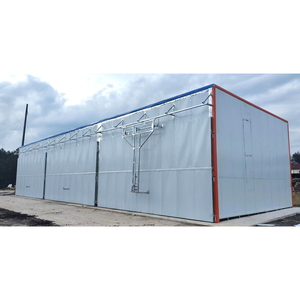
All categories
Featured selections
Trade Assurance
Buyer Central
Help Center
Get the app
Become a supplier

(2577 products available)



























The function of an UV drying oven is to cure materials by exposing them to ultraviolet light. Generally speaking, there are two main types of UV drying curing ovens which are linear and conveyor.
Linear UV ovens
A linear UV drying oven uses an ultraviolet lamp as a heat source to dry and cure ink or coating applied to a substrate. The oven has a fixed-length chamber, usually in a straight line, where the substrate passes under or over the UV light source. As the substrate moves through the oven, the UV light cures the ink or coating by chemically reacting to it. Linear UV drying ovens are more suited for small production runs of materials that can fit into the linear oven's length.
Conveyor UV ovens
A conveyor UV drying oven also uses ultraviolet lamps to dry and cure ink or coating applied to various substrates. This type of UV drying oven has a conveyor belt that continuously moves materials through the oven's chamber, exposing them to different UV light sources positioned closely. This design allows for a faster production speed than linear UV ovens. Furthermore, the materials do not have to be manually loaded in and out, making the process more efficient and suitable for higher-volume production. Nonetheless, a conveyor UV drying oven may take up more space because of the conveyor belt mechanism compared to linear designs with no moving parts.
The specifications of a UV curing oven can vary depending on the application requirements. Here are some key specifications along with maintenance requirements:
Wavelengths
UV drying ovens used for curing purposes have multiple wavelengths. The typical wavelength range is from 200 to 400 nm. UV wavelengths for curing are usually between 320 to 365 nm. Customers can choose different types of ovens depending on the curing material.
Radiant intensity
The radiant intensity of a UV drying oven indicates the amount of energy (or irradiance) that is emitted by the source. It is measured in watts per square meter (W/m²) or milliwatts per square centimeter (mW/cm²). The radiant intensity of a UV drying oven can vary based on its type, design, and the specific UV lamps used. For example, a handheld UV drying exposure is typically at 5 to 10 W/m², and a benchtop UV drying oven may have a radiant intensity of 200 to 500 W/m². Larger, more powerful units such as conveyor belt UV drying ovens can have radiant intensities ranging from 800 to 2000 W/m² or even higher.
Curing time
UV drying ovens cure materials in a very short amount of time, typically between 5 seconds and 3 minutes. The actual curing time depends on various factors, such as the oven type, radiant intensity, the wavelength of the UV light, and the chemical formulation of the material being cured, etc.
Power supply
A UV drying oven is an electrical device that typically operates on standard voltage power, such as 110/230V. The power frequency is equal to 50-60Hz.
Operating temperature
UV drying ovens maintain a stable internal environment to ensure the proper operation of curing equipment. Thus, the ovens are designed to have a maximum operating temperature that is safe for the UV lamp curing process. It is typically around 60 to 80 degrees Celsius.
The maintenance of UV drying ovens is crucial to ensuring safety, longevity, and optimal performance. Here are some key maintenance requirements based on specific parts of the oven:
UV lamp
Cleaning - Regularly clean the lamp surface with a lint-free cloth or mild glass cleaner to remove dust or residues.
Replacement - Follow the manufacturer's guidelines for lamp replacement based on usage hours or intensity decline.
Reflector
Cleaning - Periodically clean the reflector surface to remove any contaminants that may obstruct UV light output.
Cooling system
Fan or blower - Inspect and clean the fan or blower used to dissipate heat from the UV lamp. Ensure it functions properly.
Housing and work surface
Regularly clean the housing and work surface of the oven to remove dust, spills, and contaminants using a non-abrasive cleanser.
UV drying ovens have many uses in the industrial manufacturing of products that require instant curing on the surface of those products. The glass in a UV drying oven helps focus the UV light on the surface area. Some industries that use UV curing ovens for joint bonding, for coating, for printing products, and for making electronics with soldering and adhesives include the following:
Application requirements analysis:
Before purchasing a UV drying oven, users should analyze the application needs. Consider aspects such as the materials to be dried, the drying speed required, the production capacity, and the process parameters. This analysis will help users determine the appropriate size, power, and performance of the UV drying oven.
Oven type selection:
Users can choose suitable UV drying ovens based on their production processes and needs. For example, a flatbed UV dryer is appropriate for screen printing on flat media, while a conveyor belt UV dryer suits applications involving both flat and textured materials.
Oven quality and brand:
Users should select UV drying ovens manufactured by reputable brands with good quality. Investigate the oven's build quality, stability, and reliability. Moreover, check for any certifications or compliance with industry standards.
Energy consumption and operating costs:
Consider the energy consumption and operating costs of the UV drying oven. Compare the energy efficiency and operating costs of different models to optimize production costs.
Maintenance and service:
Choose a manufacturer that provides good after-sales service and maintenance support. This ensures users can obtain timely technical assistance and maintenance services when encountering problems during use.
Budget and return on investment:
Consider the budget and return on investment for the UV drying oven. Compare different models' performance and features to make a choice that aligns with the budget and maximizes investment return.
Testing and feedback:
If possible, users can test the performance of a UV drying oven before purchasing. Pay attention to aspects such as drying efficiency, product quality, operation, and control. Additionally, listen to other users' feedback and experiences to gain more insights into the advantages and disadvantages of different models.
Q1: What types of materials are suitable for UV curing?
A1: UV curing is compatible with a diverse range of materials, including but not limited to plastics, coatings, adhesives, inks, and varnishes. Nonetheless, discussing material compatibility is imperative before opting for a UV drying oven.
Q2: How agile UV drying ovens are when adapting to various production lines?
A2: UV drying ovens are incredibly versatile and can be seamlessly integrated into different production lines. Whether working with existing setups or creating bespoke manufacturing workflows, these ovens remain an effective solution for rapid curing and drying processes.
Q3: Can employees safely operate a UV drying oven without special training?
A3: The user manual provided by the manufacturer is essential in determining the safety precautions and training requirements for operating a particular model of UV drying oven. However, as a general guideline, it is always prudent to ensure that personnel operating any equipment, including ovens, are adequately trained and familiar with its safe and proper use. This may include training on safety measures, handling procedures, and any specific requirements outlined in the manufacturer's manual.
Q4: Does a UV drying oven affect the hardness of a printed surface?
The primary function of a UV drying oven is to cure materials using ultraviolet light rather than heat. In this process, a chemical reaction occurs, enhancing the printed material's hardness and durability. Using a UV drying oven can increase the hardness of a printed surface, making it more resistant to scratches, wear, and other forms of damage.